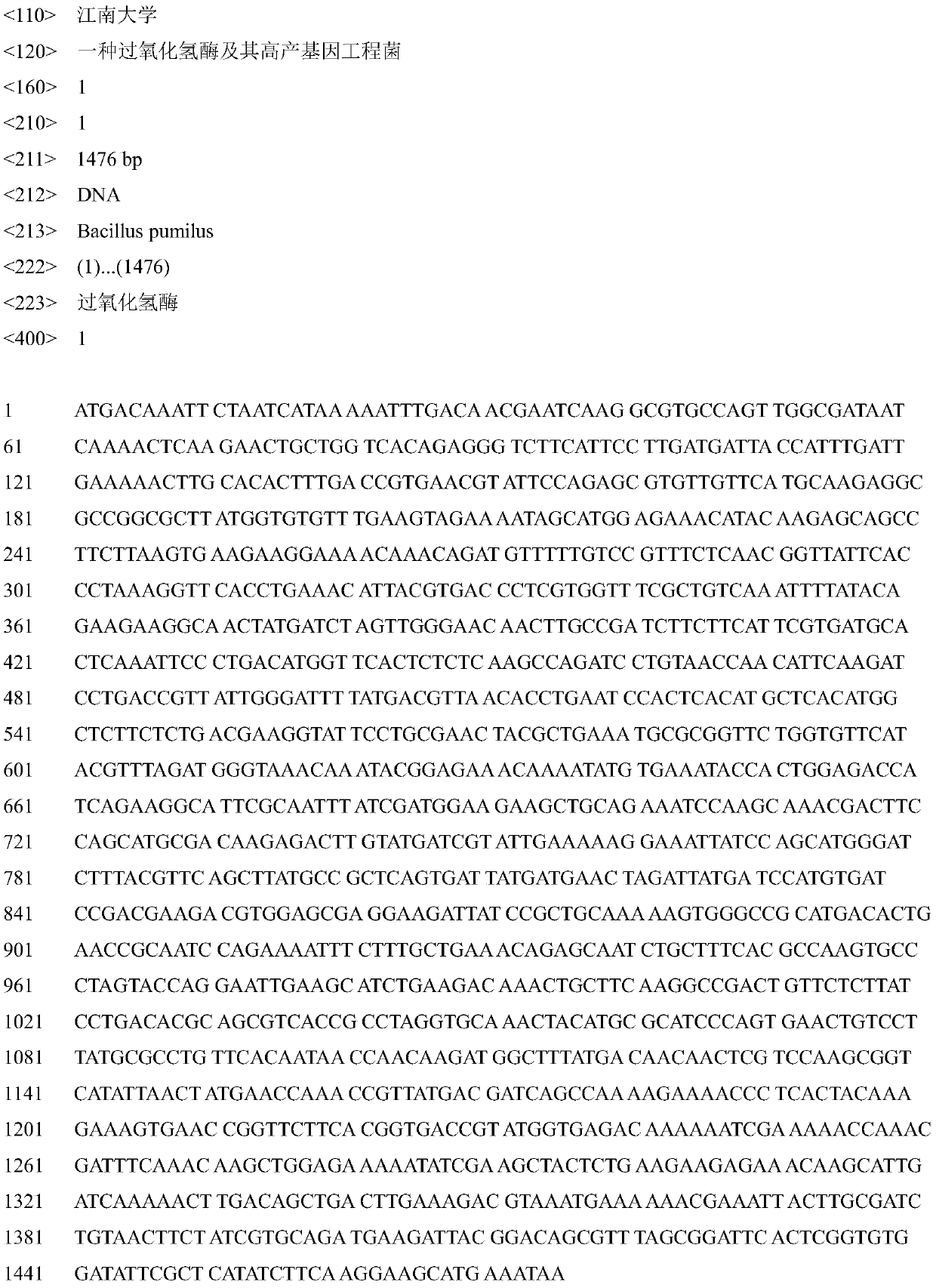A kind of catalase and its high-yielding genetically engineered bacteria
A technology of catalase and genetically engineered bacteria, applied in the fields of genetic engineering and enzyme engineering, can solve the problems of many by-products, low yield, large workload, etc.
- Summary
- Abstract
- Description
- Claims
- Application Information
AI Technical Summary
Problems solved by technology
Method used
Image
Examples
Embodiment 1
[0020] Example 1: Construction and Transformation of Recombinant Plasmid pET-28a-KatX2
[0021] [1] Genomic DNA of Bacillus pumilus was used as a template.
[0022] [2] According to the catalase gene sequence of Bacillus pumilus (KatX2, GenBank Accession No. CP011150.1) and the restriction site on the pET-28a or pMA5 plasmid, the KatX2 gene primers were designed.
[0023] P1: 5'-ACGCGTCGACAAATGACAAATTCAAATCAT-3' (Sal I)
[0024] P2: 5'-CCGCTCGAGTTATTTCATGCTTCCTTG-3'(Xho I)
[0025] [3] Using the DNA of Bacillus pumilus as a template to do PCR amplification to obtain the gene. PCR amplification system: template 2 μL, upstream and downstream primers P1 and P2 0.5 μL each, dNTP Mix 4 μL, 10×Ex Taq Buffer 5 μL, sterilized ddH 2 O 37 μL, Ex Taq DNA polymerase 1 μL. PCR reaction conditions: 94°C pre-denaturation, 5min, one cycle; 94°C denaturation, 1min, 58°C annealing, 1min, 72°C extension, 1min 30s, 30 cycles; 72°C, 10min, one cycle; 15°C, 10min, a cycle. The PCR product was...
Embodiment 2
[0028] Example 2: Preparation of Escherichia coli Competent and Transformation of Plasmid
[0029][1] Preparation of competent Escherichia coli. Activate the monoclonal Escherichia coli in 10ml LB medium, then transfer to 37°C shaking culture to OD 600 0.35 to prepare the competent state; put the cultured bacterial solution in ice water, shake gently to cool the bacterial solution for about 10 minutes; prepare several 1.5ml centrifuge tubes for sterilization, and divide the bacterial solution into the tubes, The amount of bacteria in the tube is 1.2ml, put the centrifuge tube in ice; centrifuge the bacteria solution at 8000r / min for 10-20s, let it stand in ice water for 2min, discard the supernatant, add pre-cooled 0.1M CaCl 2 400μL, gently blow the suspension, put it in ice for 15min (repeat this step 2-3 times); finally, add pre-cooled 0.1M CaCl 2 80 μL, gently pipette the suspension and place it on ice.
[0030] [2] Transformation of plasmids. Take the competent cell...
Embodiment 3
[0031] Embodiment 3: Construction and transformation of recombinant plasmid pET-28a-KatX2
[0032] [1] Genomic DNA of Bacillus pumilus was used as a template.
[0033] [2] According to the catalase gene sequence of Bacillus pumilus (KatX2, GenBank Accession No. CP011150.1) and the restriction site on the pMA5 plasmid, KatX2 gene primers were designed.
[0034] P3: 5'-CGGGATCCATGACAAATTCAAATCATAAAAAT-3'(BamH I)
[0035] P4: 5'-CGACGCGTTTATTCATGCTTCCTTG-3'(MluI)
[0036] [3] Using the DNA of Bacillus pumilus as a template to do PCR amplification to obtain the gene. PCR amplification system: template 2 μL, upstream and downstream primers P3 and P4 0.5 μL each, dNTP Mix 4 μL, 10×Ex Taq Buffer 5 μL, sterilized ddH 2 O 37 μL, Ex Taq DNA polymerase 1 μL. PCR reaction conditions: 94°C pre-denaturation, 5min, one cycle; 94°C denaturation, 1min, 58°C annealing, 1min, 72°C extension, 1min 30s, 30 cycles; 72°C, 10min, one cycle; 15°C, 10min, a cycle. The PCR product was purified and...
PUM
 Login to View More
Login to View More Abstract
Description
Claims
Application Information
 Login to View More
Login to View More - R&D
- Intellectual Property
- Life Sciences
- Materials
- Tech Scout
- Unparalleled Data Quality
- Higher Quality Content
- 60% Fewer Hallucinations
Browse by: Latest US Patents, China's latest patents, Technical Efficacy Thesaurus, Application Domain, Technology Topic, Popular Technical Reports.
© 2025 PatSnap. All rights reserved.Legal|Privacy policy|Modern Slavery Act Transparency Statement|Sitemap|About US| Contact US: help@patsnap.com

